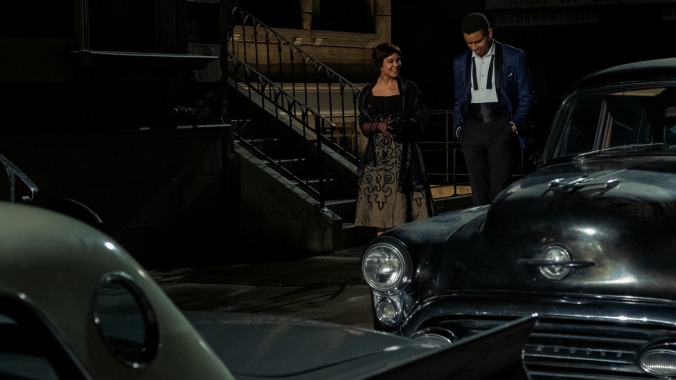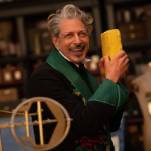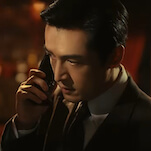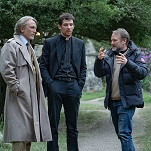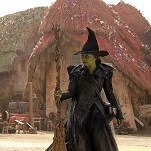Tessa Thompson (left) and Nnamdi Asomugha in Sylvie’s Love Photo: Amazon Studios
Sylvie’s Love is the kind of movie cinephiles are talking about when they complain that “They don’t make them like they used to.” It’s a film for adults and about adults. More specifically, though, it resembles the films “they” used to make in the sense that it harkens back to the aesthetic language of classic Hollywood, which isn’t just unfashionable now but basically nonexistent. The plot recalls a “woman’s film” from the ’40s or ’50s: An upper crust etiquette teacher’s daughter, Sylvie (Tessa Thompson), falls in love with Robert (Nnamdi Asomugha), a jazz saxophonist below her station in late-’50s Harlem, despite being engaged to another man. Writer-director Eugene Ashe evokes the big emotions of melodramas from the period without hewing too closely to the genre’s characterizations, and he employs a grab bag of stylistic elements from the midcentury to lend his romantic drama the feeling of looking at an an old photograph. Everything from the backlot sets to the costume design to the opening credits font screams Golden Age nostalgia.
The obvious difference between Sylvie’s Love and those films of yore is the all-Black cast. Ashe makes the notable, conscious choice not to frame his love story against a backdrop of persecution or fear. While his movie acknowledges the Civil Rights Movement and features a scene of all-too-typical genteel liberal racism, persecution isn’t the focus. Instead, the predominant emotions are joy and tenderness, sentiments that have been afforded to white stories since cinema’s beginning. By foregrounding characters who have too rarely been the center of this genre, Ashe insists that such narratives are the province of all.
Sylvie’s Love hits all the standard notes of a romance plot with relative aplomb. The meet-cute arrives in stages. Robert first notices Sylvie while she’s dancing to Bill Haley’s “See You Later, Alligator” in her father’s record store. Later, Sylvie falls for Robert while watching him play a show, neatly captured in a sustained close-up on Thompson’s face. There’s the separation based on buried secrets and class differences and diverging life tracks. Eventually, the two reunite as different people in changing times, which adds a new set of difficulties to their relationship, but their love endures. Ashe’s script doesn’t disguise the familiar narrative beats but rather proudly displays them. That Sylvie’s Love broadly operates within the confines of a recognizable genre works in its favor because it lets the performances take the emotional lead, with Ashe’s script and direction supporting their work.
One interesting wrinkle is that Sylvie’s Love focuses on Sylvie’s professional world as much as Robert’s. Though we see a tour of New York jazz culture, complete with flashy production design and casual name dropping, Ashe retains a tourist’s eye in that realm by focusing on surfaces and rarely digging deeper. Sylvie, on the other hand, chases after her very specific dream of becoming a television producer, a world for which Ashe has a much better feel. (Though the director himself is a former recording artist.) He follows her Peggy Olson-esque rise from production assistant on a cooking show—where it’s her job to hand ingredients to the host from off-camera—to a professional with a corner office. Inspired if too infrequent, these glimpses into the world of a different medium’s first Golden Age add a personal touch to the drama.
Yet Sylvie’s Love lacks the ineffable spark that keeps it from fully transcending its period dress-up. There’s a pervasive self-consciousness on display that veers from delightful to forced depending on the goals of each scene. Sometimes the cast and the production design embrace the artifice strongly enough to make it look and sound organic. Other times, it just appears… artificial. Some of the problem certainly lies with the gap in quality between Thompson and Asomugha’s performances. The former adopts a classical performance style while also supplying her own personality and unique contemporary gestures; she accomplishes the genuine feat of broadly, legibly communicating the emotions without betraying nuance or complexity. By contrast, Asomugha sports a winning smile and a charming Sidney Poitier-like pose, but it’s just not enough to fill out a role. His limitations become painfully evident whenever he needs to emote beyond a certain register or convey a buried feeling. There’s enough chemistry between the two to generate tension, and it’s fine that Thompson carries a movie named after her character. But the imbalance is a problem.
Still, Sylvie’s Love manages to rise above being just a throwback exercise. Ashe and his cast lend the film a sincere pulse that propels a compelling romance while massaging its flaws. It’s clear why Amazon Studios plans to release the film on Prime just days before Christmas. Beautiful people in stunning attire falling in love against striking backdrops have been a staple of Hollywood since its beginning. Sometimes an earnest homage to that old tradition can be a worthy balm for the end-of-the-year blues.
